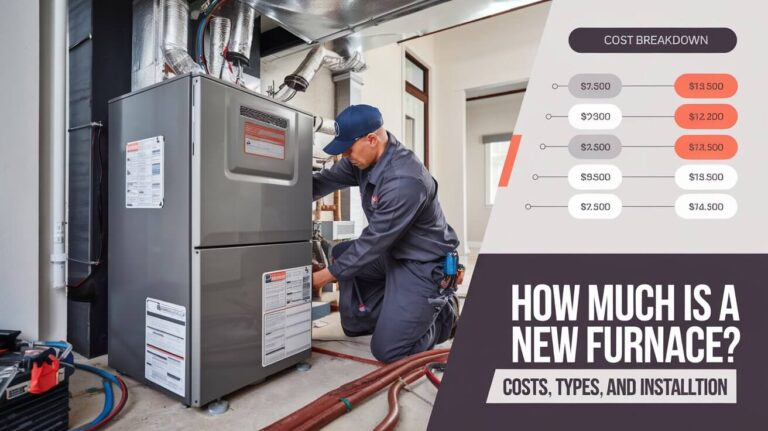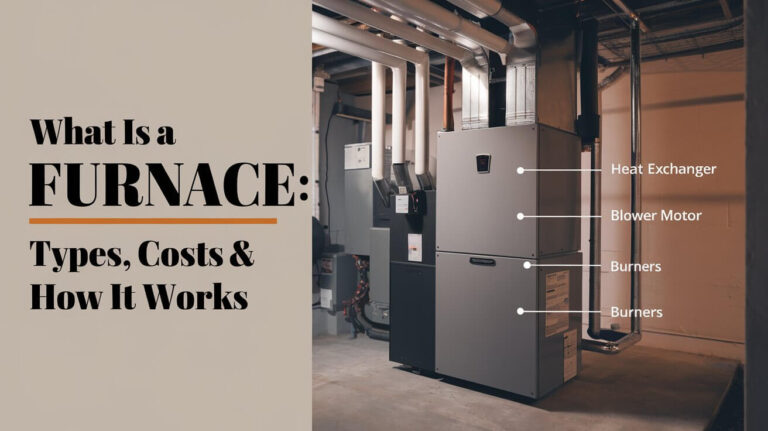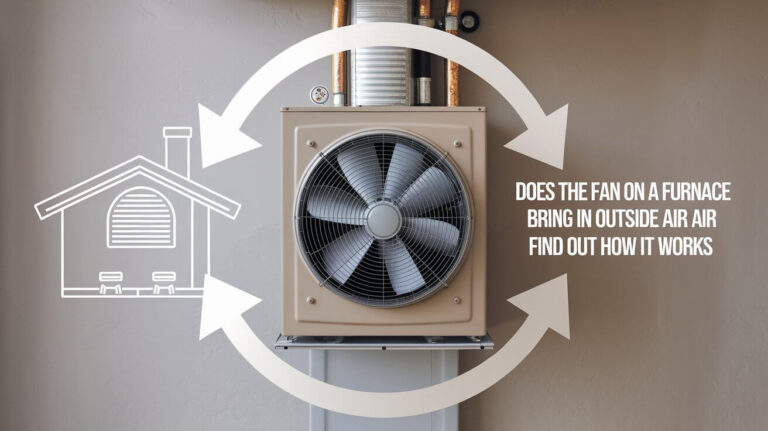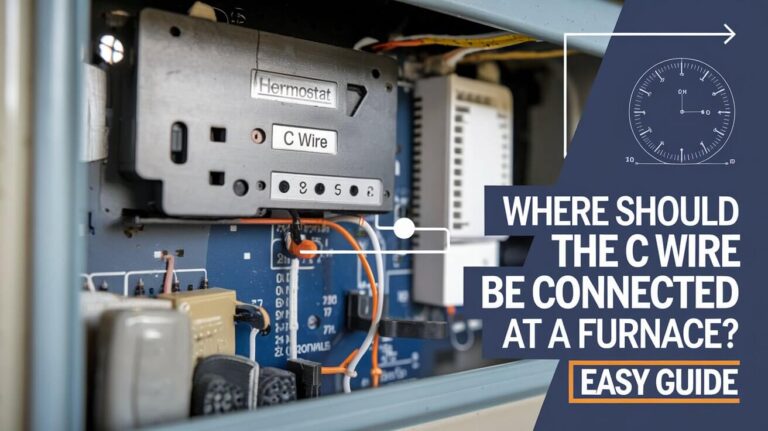How Often to Change Furnace Filter: Essential Tips for Homeowners
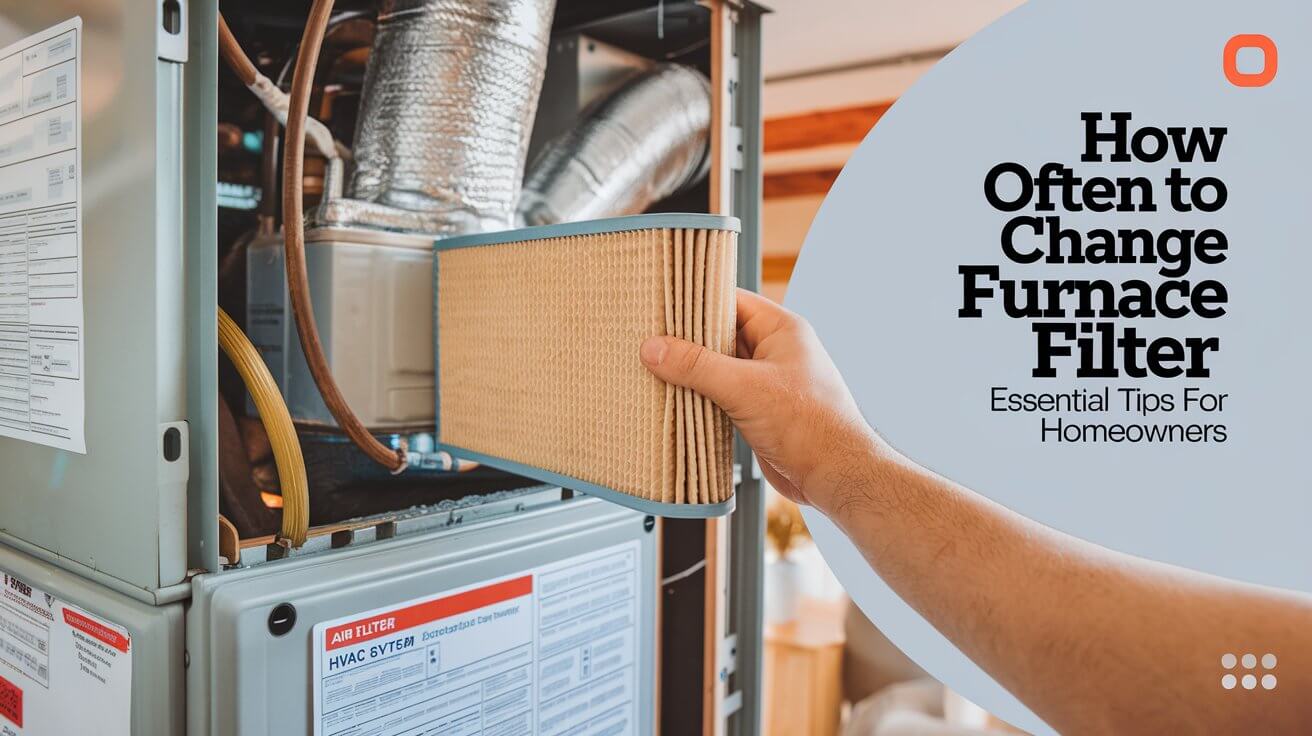
Your furnace filter is a vital component in keeping your HVAC system running smoothly and maintaining healthy air quality in your home. But how often should you change it? The answer depends on several factors such as the type of filter you use, how many people live in your home, and whether you have pets. On average, furnace filters should be replaced every 90 days, but there are instances where more frequent changes might be necessary.
In this comprehensive guide, we’ll dive deep into everything you need to know about furnace filters, including replacement timelines, how various factors influence their lifespan, and why regular maintenance is essential. By the end, you’ll have a clear understanding of how to best manage your furnace filter to keep your system running efficiently and your air clean.
General Recommendations for Furnace Filter Replacement
The Standard Replacement Timeline
For most households, the standard recommendation is to change furnace filters every 90 days. This applies to most basic furnace filters, particularly those made of fiberglass. These filters trap larger airborne particles like dust and debris, but as they get clogged, their efficiency drops, making it harder for your furnace to work properly. Regular filter changes help prevent your furnace from overworking, which can save energy and extend its lifespan.
Why the 90-Day Rule?
The 90-day rule is a guideline that takes into account normal furnace usage. Over the course of three months, the filter will gradually become clogged with dust, pollen, pet dander, and other airborne particles. Once the filter is full, it can no longer effectively clean the air, forcing the furnace to work harder to push air through the clogged filter. This not only drives up energy bills but can also lead to overheating and damage to the furnace over time.
Regular replacement ensures that your system remains energy-efficient and reduces the likelihood of breakdowns due to filter-related issues.
Seasonal Considerations
In some cases, you may need to change your furnace filter more frequently. For instance, during the peak heating season in winter or the height of summer when the HVAC system is working overtime, filters can get clogged faster. It’s a good idea to inspect your filter at least once a month during these periods and replace it as necessary.
For regions with milder winters, the 90-day replacement schedule might be sufficient year-round, but for areas with extreme temperatures, checking the filter monthly is advised.
Factors That Affect How Often to Change Your Furnace Filter
There isn’t a one-size-fits-all rule when it comes to furnace filter replacement. Several factors can influence how often you should swap out your filter, including the type of filter, your household’s specific conditions, and external environmental factors.
Filter Type
Fiberglass Filters
Fiberglass filters are among the most common and affordable filters on the market. However, they are also the least efficient. These filters typically need to be replaced every 30 days. While they do an adequate job of trapping large particles like dust and debris, they are less effective at capturing smaller particles like pet dander or mold spores. As a result, households with allergy sufferers or pets may want to opt for a more efficient filter option.
Pleated Filters
Pleated filters, made of polyester or cotton, are much more efficient than fiberglass filters. They are designed to capture smaller particles and can last up to 90 days. These filters are often more expensive, but their higher efficiency and longer lifespan make them a popular choice for most homeowners.
HEPA Filters
High-Efficiency Particulate Air (HEPA) filters are the gold standard in air filtration. They can capture up to 99.97% of airborne particles, making them ideal for homes with allergy sufferers, smokers, or pets. HEPA filters can last anywhere from six months to a year, but their high level of filtration may also reduce airflow, which could cause your furnace to work harder. Therefore, it’s important to follow the manufacturer’s guidelines when using a HEPA filter.
Filter Thickness
The thickness of your furnace filter can also affect how often it needs to be replaced. Thicker filters, such as 4- or 5-inch filters, can trap more debris and typically last longer than thinner filters.
- 1-inch filters: Replace every 1-3 months
- 2-inch filters: Replace every 1-3 months
- 4-inch filters: Replace every 6-9 months
- 5-inch filters: Replace every 9-12 months
The thickness of your filter is often dictated by your HVAC system’s design. Be sure to check the specifications of your furnace to ensure you are using the appropriate filter size.
Household Variables
Homes with Pets
If you have pets, especially those that shed, your filter will become clogged more quickly due to pet hair and dander. In homes with multiple pets, filters may need to be changed as frequently as every month to maintain good air quality and prevent your HVAC system from overworking.
Allergy Sufferers
For people with allergies, the type of filter and its replacement schedule are crucial. Allergens like dust, pollen, and mold can quickly clog a filter, leading to poor indoor air quality. If anyone in your home suffers from allergies or respiratory conditions, consider upgrading to a higher-quality filter and replacing it every 1-2 months.
Number of Occupants
The more people living in your home, the more contaminants like dust and dander will be present in the air. Larger households may find they need to replace filters more often to maintain optimal air quality.
Environmental Factors
If you live in an area with high levels of pollution, smoke (from wildfires, for example), or pollen, you’ll likely need to change your filter more frequently. These outdoor particles can quickly clog filters, significantly reducing their lifespan and lowering indoor air quality.
Special Circumstances for Changing Furnace Filters
There are some specific situations where you should pay extra attention to your furnace filter, as it may require more frequent replacement.
After Home Renovation or Construction
If you’ve recently completed any home renovations or construction, it’s essential to change your furnace filter more frequently. Construction generates a significant amount of dust and debris, which can quickly clog your filter. In these cases, it’s advisable to replace the filter every two weeks during and shortly after the renovation period.
High Pollution or Wildfire-Prone Areas
Homes in areas with high pollution or frequent wildfires should replace filters more often. Particles from smoke, dust, and ash can quickly clog filters, significantly reducing their lifespan and lowering indoor air quality. During periods of heavy smoke, consider checking and changing your filter every month.
Signs It’s Time to Replace Your Furnace Filter
While following a regular replacement schedule is important, there are also some clear signs that your furnace filter needs to be changed.
Visual Inspection
One of the easiest ways to determine if your filter needs to be replaced is by simply looking at it. A clean filter will appear white, while a dirty one will be dark grey or brown, indicating it’s full of debris. Regular visual inspections can help you avoid waiting too long between filter changes.
Higher Energy Bills
A clogged filter makes it harder for your furnace to push air through, which forces the system to work harder and use more energy. If you notice a sudden spike in your heating bill, it might be time to replace your filter.
Reduced Air Flow
If you notice a decrease in airflow from your vents, this could be a sign that your filter is clogged and needs to be replaced. Poor airflow can also lead to uneven heating or cooling throughout your home.
Increase in Dust or Allergies
If you start to notice more dust settling on surfaces around your home or if household members are experiencing allergy symptoms more frequently, your furnace filter may no longer be effectively trapping airborne particles.
Furnace Cycling On and Off
A furnace that frequently cycles on and off could be a sign that your filter is clogged. When a furnace has to work harder to push air through a dirty filter, it may overheat and shut down as a safety precaution. Replacing the filter can help restore normal function.
Benefits of Regularly Changing Furnace Filters
Improved HVAC Efficiency
A clean filter allows air to flow freely through your HVAC system, making it easier for the furnace to maintain a consistent temperature. This improved efficiency can reduce your energy bills by up to 15%.
Extended Furnace Lifespan
Replacing your furnace filter regularly helps reduce wear and tear on your system. A clogged filter forces the furnace to work harder, which can cause components to wear out faster. By keeping your filter clean, you’ll help ensure that your furnace lasts as long as possible, potentially saving you thousands of dollars in repair or replacement costs.
Better Air Quality
Furnace filters play a key role in improving the air quality in your home. They trap airborne particles like dust, pollen, pet dander, and bacteria, preventing them from circulating throughout your home. Regular filter replacement ensures that these particles are captured efficiently, which is especially important for homes with allergy sufferers or pets.
Choosing the Right Furnace Filter for Your Home
Understanding MERV Ratings
The MERV (Minimum Efficiency Reporting Value) rating measures how effectively a filter can capture particles. Filters with higher MERV ratings can capture smaller particles, but they can also restrict airflow, which may reduce the efficiency of your HVAC system.
- MERV 1-4: These filters capture large particles like dust and lint but are not effective against smaller pollutants.
- MERV 5-8: A better option for most homes, these filters can capture smaller particles like mold spores and pet dander.
- MERV 9-12: Highly efficient, these filters are great for allergy sufferers, as they can trap fine particles like pollen and bacteria.
- MERV 13-16: Typically used in hospitals or other sensitive environments, these filters can trap even smaller particles, including smoke and viruses.
Reusable vs. Disposable Filters
Some filters are reusable and can be# How Often Should You Change Your Furnace Filter?
Your furnace filter is a vital component in keeping your HVAC system running smoothly and maintaining healthy air quality in your home. But how often should you change it? The answer depends on several factors, such as the type of filter you use, the number of people in your home, and whether you have pets. On average, furnace filters should be replaced every 90 days, but there are instances where more frequent changes might be necessary.
In this comprehensive guide, we’ll dive deep into everything you need to know about furnace filters, including replacement timelines, how various factors influence their lifespan, and why regular maintenance is essential. By the end, you’ll have a clear understanding of how to best manage your furnace filter to keep your system running efficiently and your air clean.
General Recommendations for Furnace Filter Replacement
The Standard Replacement Timeline
For most households, the standard recommendation is to change furnace filters every 90 days. This applies to basic furnace filters, particularly those made of fiberglass. These filters trap larger airborne particles like dust and debris, but as they get clogged, their efficiency drops, making it harder for your furnace to work properly. Regular filter changes help prevent your furnace from overworking, which can save energy and extend its lifespan.
Why the 90-Day Rule?
The 90-day rule is a guideline that considers normal furnace usage. Over three months, the filter will gradually become clogged with dust, pollen, pet dander, and other airborne particles. Once the filter is full, it can no longer effectively clean the air, forcing the furnace to work harder to push air through the clogged filter. This not only drives up energy bills but can also lead to overheating and damage to the furnace over time.
Regular replacement ensures that your system remains energy-efficient and reduces the likelihood of breakdowns due to filter-related issues.
Seasonal Considerations
In some cases, you may need to change your furnace filter more frequently. For instance, during the peak heating season in winter or the height of summer when the HVAC system is working overtime, filters can get clogged faster. It’s advisable to inspect your filter at least once a month during these periods and replace it as necessary.
For regions with milder winters, the 90-day replacement schedule might be sufficient year-round, but for areas with extreme temperatures, checking the filter monthly is advised.
Factors That Affect How Often to Change Your Furnace Filter
There isn’t a one-size-fits-all rule when it comes to furnace filter replacement. Several factors can influence how often you should swap out your filter, including the type of filter, your household’s specific conditions, and external environmental factors.
Filter Type
Fiberglass Filters
Fiberglass filters are among the most common and affordable filters on the market. However, they are also the least efficient. These filters typically need to be replaced every 30 days. While they do an adequate job of trapping large particles like dust and debris, they are less effective at capturing smaller particles like pet dander or mold spores. As a result, households with allergy sufferers or pets may want to opt for a more efficient filter option.
Pleated Filters
Pleated filters, made of polyester or cotton, are much more efficient than fiberglass filters. They are designed to capture smaller particles and can last up to 90 days. These filters are often more expensive, but their higher efficiency and longer lifespan make them a popular choice for most homeowners.
HEPA Filters
High-Efficiency Particulate Air (HEPA) filters are the gold standard in air filtration. They can capture up to 99.97% of airborne particles, making them ideal for homes with allergy sufferers, smokers, or pets. HEPA filters can last anywhere from six months to a year, but their high level of filtration may also reduce airflow, which could cause your furnace to work harder. Therefore, it’s important to follow the manufacturer’s guidelines when using a HEPA filter.
Filter Thickness
The thickness of your furnace filter can also affect how often it needs to be replaced. Thicker filters, such as 4- or 5-inch filters, can trap more debris and typically last longer than thinner filters.
- 1-inch filters: Replace every 1-3 months
- 2-inch filters: Replace every 1-3 months
- 4-inch filters: Replace every 6-9 months
- 5-inch filters: Replace every 9-12 months
The thickness of your filter is often dictated by your HVAC system’s design. Be sure to check the specifications of your furnace to ensure you are using the appropriate filter size.
Household Variables
Homes with Pets
If you have pets, especially those that shed, your filter will become clogged more quickly due to pet hair and dander. In homes with multiple pets, filters may need to be changed as frequently as every month to maintain good air quality and prevent your HVAC system from overworking.
Allergy Sufferers
For people with allergies, the type of filter and its replacement schedule are crucial. Allergens like dust, pollen, and mold can quickly clog a filter, leading to poor indoor air quality. If anyone in your home suffers from allergies or respiratory conditions, consider upgrading to a higher-quality filter and replacing it every 1-2 months.
Number of Occupants
The more people living in your home, the more contaminants like dust and dander will be present in the air. Larger households may find they need to replace filters more often to maintain optimal air quality.
Environmental Factors
If you live in an area with high levels of pollution, smoke (from wildfires, for example), or pollen, you’ll likely need to change your filter more frequently. These outdoor particles can quickly clog filters, significantly reducing their lifespan and lowering indoor air quality.
Special Circumstances for Changing Furnace Filters
There are specific situations where you should pay extra attention to your furnace filter, as it may require more frequent replacement.
After Home Renovation or Construction
If you’ve recently completed any home renovations or construction, it’s essential to change your furnace filter more frequently. Construction generates a significant amount of dust and debris, which can quickly clog your filter. In these cases, it’s advisable to replace the filter every two weeks during and shortly after the renovation period.
High Pollution or Wildfire-Prone Areas
Homes in areas with high pollution or frequent wildfires should replace filters more often. Particles from smoke, dust, and ash can quickly clog filters, significantly reducing their lifespan and lowering indoor air quality. During periods of heavy smoke, consider checking and changing your filter every month.
Signs It’s Time to Replace Your Furnace Filter
While following a regular replacement schedule is important, there are clear signs that your furnace filter needs to be changed.
Visual Inspection
One of the easiest ways to determine if your filter needs to be replaced is by simply looking at it. A clean filter will appear white, while a dirty one will be dark grey or brown, indicating it’s full of debris. Regular visual inspections can help you avoid waiting too long between filter changes.
Higher Energy Bills
A clogged filter makes it harder for your furnace to push air through, which forces the system to work harder and use more energy. If you notice a sudden spike in your heating bill, it might be time to replace your filter.
Reduced Air Flow
If you notice a decrease in airflow from your vents, this could be a sign that your filter is clogged and needs to be replaced. Poor airflow can also lead to uneven heating or cooling throughout your home.
Increase in Dust or Allergies
If you start to notice more dust settling on surfaces around your home or if household members are experiencing allergy symptoms more frequently, your furnace filter may no longer be effectively trapping airborne particles.
Furnace Cycling On and Off
A furnace that frequently cycles on and off could be a sign that your filter is clogged. When a furnace has to work harder to push air through a dirty filter, it may overheat and shut down as a safety precaution. Replacing the filter can help restore normal function.
Benefits of Regularly Changing Furnace Filters
Improved HVAC Efficiency
A clean filter allows air to flow freely through your HVAC system, making it easier for the furnace to maintain a consistent temperature. This improved efficiency can reduce your energy bills by up to 15%.
Extended Furnace Lifespan
Replacing your furnace filter regularly helps reduce wear and tear on your system. A clogged filter forces the furnace to work harder, which can cause components to wear out faster. By keeping your filter clean, you’ll help ensure that your furnace lasts as long as possible, potentially saving you thousands of dollars in repair or replacement costs.
Better Air Quality
Furnace filters play a key role in improving the air quality in your home. They trap airborne particles like dust, pollen, pet dander, and bacteria, preventing them from circulating throughout your home. Regular filter replacement ensures that these particles are captured efficiently, which is especially important for homes with allergy sufferers or pets.
Choosing the Right Furnace Filter for Your Home
Understanding MERV Ratings
The MERV (Minimum Efficiency Reporting Value) rating measures how effectively a filter can capture particles. Filters with higher MERV ratings can capture smaller particles, but they can also restrict airflow, which may reduce the efficiency of your HVAC system.
- MERV 1-4: These filters capture large particles like dust and lint but are not effective against smaller pollutants.
- MERV 5-8: A better option for most homes, these filters can capture smaller particles like mold spores and pet dander.
- MERV 9-12: Highly efficient, these filters are great for allergy sufferers, as they can trap fine particles like pollen and bacteria.
- MERV 13-16: Typically used in hospitals or other sensitive environments, these filters can trap even smaller particles, including smoke and viruses.
Reusable vs. Disposable Filters
Some filters are reusable and can be washed and used again, while others are disposable and# How Often Should You Change Your Furnace Filter?
Your furnace filter plays a crucial role in maintaining not just the efficiency of your heating system, but also the air quality in your home. With proper maintenance, you can extend the lifespan of your furnace and ensure a comfortable living environment. But how often should you really change your furnace filter? In general, the rule of thumb is to replace it every 90 days, but various factors may necessitate more frequent changes.
In this detailed guide, we’ll explore the recommended replacement schedules, factors that affect how often you should change your filter, signs indicating it’s time for a replacement, and the benefits of maintaining a clean filter. By the end, you’ll have all the knowledge you need to keep your HVAC system running smoothly and your home’s air clean.
General Recommendations for Furnace Filter Replacement
The Standard Replacement Timeline
For most households, changing the furnace filter every 90 days is standard practice. This timeframe is based on typical usage and the ability of filters to trap larger particles like dust, pollen, and debris. However, as filters accumulate dust and become clogged, their efficiency diminishes. Regular replacements help avoid unnecessary strain on your HVAC system, which can lead to higher energy costs and potential damage over time.
Why the 90-Day Rule?
The 90-day guideline serves as a baseline for most home environments. Over three months, your filter will trap contaminants, gradually clogging up with dust, pet hair, and allergens. Once full, the filter becomes less effective, forcing the furnace to work harder to circulate air. This increased strain not only raises energy bills but may also lead to overheating and premature system failure.
By adhering to this schedule, you can maintain an efficient HVAC system and reduce the risk of costly repairs due to neglect.
Seasonal Considerations
Certain seasons may necessitate more frequent filter changes. For example, during the peak heating months in winter or the height of summer when your air conditioning is running, filters tend to clog more rapidly. In these times, inspecting your filter monthly and replacing it when necessary is a wise approach.
In regions with mild winters, a quarterly schedule may be adequate year-round, but areas with extreme seasonal variations may require more diligent monitoring.
Factors That Affect How Often to Change Your Furnace Filter
While the 90-day guideline is a solid starting point, several factors can influence how frequently you should replace your filter.
Filter Type
Fiberglass Filters
Fiberglass filters are affordable and widely used, but they are the least efficient at capturing small particles. Typically, these filters should be replaced every 30 days, as they become clogged quickly and are less effective in homes with allergies or pets.
Pleated Filters
Pleated filters are made of polyester or cotton and offer better efficiency than fiberglass. They can generally last up to 90 days, making them a more popular choice for homeowners. They effectively trap smaller particles and improve air quality significantly.
HEPA Filters
High-Efficiency Particulate Air (HEPA) filters are top-tier in filtration, capturing up to 99.97% of airborne particles. Though they can last from six months to a year, their density may restrict airflow, potentially causing your system to work harder. Always check the manufacturer’s guidelines for specific replacement schedules.
Filter Thickness
The thickness of your furnace filter can also impact its lifespan. Thicker filters, like 4- or 5-inch options, can capture more debris and generally last longer than their 1-inch counterparts. Here’s a quick breakdown:
- 1-inch filters: Replace every 1-3 months
- 2-inch filters: Replace every 1-3 months
- 4-inch filters: Replace every 6-9 months
- 5-inch filters: Replace every 9-12 months
Household Variables
Homes with Pets
If you have pets, especially those that shed, your filter will clog more quickly with pet hair and dander. Households with multiple pets may need to change filters monthly to maintain good air quality.
Allergy Sufferers
If someone in your home suffers from allergies, consider upgrading to a more efficient filter and replacing it every 1-2 months. Allergens like dust, pollen, and mold can clog filters rapidly, degrading indoor air quality.
Number of Occupants
More occupants mean more dust, dirt, and dander circulating in your home. Larger families may find that they need to replace filters more frequently to keep the air clean.
Environmental Factors
Living in an area with high pollution or seasonal pollen spikes can lead to faster filter clogging. If your region experiences significant air quality issues, you may need to replace your filter more often.
Special Circumstances for Changing Furnace Filters
After Home Renovation or Construction
If you’ve recently renovated your home, be prepared to change your furnace filter more frequently. Construction work creates a lot of dust, which can quickly clog filters. Consider replacing your filter every two weeks during and shortly after renovation projects.
High Pollution or Wildfire-Prone Areas
For homes in high-pollution or wildfire-prone areas, it’s critical to monitor and replace filters more frequently. Particles from smoke, dust, and ash can significantly reduce filter lifespan, so checking and changing your filter monthly during such events is advisable.
Signs It’s Time to Replace Your Furnace Filter
Regular maintenance is essential, but there are signs that your furnace filter needs immediate attention.
Visual Inspection
The simplest way to check if your filter needs replacing is by inspecting it visually. A clean filter is usually white, while a dirty one appears dark grey or brown. Regularly scheduled visual inspections can help you avoid waiting too long to change it.
Higher Energy Bills
A sudden spike in your heating or cooling bill could indicate that your filter is clogged. A dirty filter makes it harder for your furnace to push air, leading to increased energy consumption.
Reduced Air Flow
If you notice reduced airflow from your vents, this may signal a clogged filter. Poor airflow can cause uneven heating or cooling throughout your home, negatively affecting comfort.
Increase in Dust or Allergies
Increased dust settling on surfaces or rising allergy symptoms among household members are indicators that your filter may not be trapping airborne particles effectively anymore.
Furnace Cycling On and Off
Frequent cycling of your furnace can be a sign of a clogged filter. If your system has to work harder to push air through a dirty filter, it may overheat and shut off as a precaution. Replacing the filter can help restore normal operation.
Benefits of Regularly Changing Furnace Filters
Improved HVAC Efficiency
Regularly replacing your furnace filter allows for optimal airflow, making it easier for your HVAC system to maintain a comfortable temperature. Improved efficiency can reduce energy bills by up to 15%.
Extended Furnace Lifespan
Routine filter replacement helps reduce wear and tear on your heating system. A clogged filter forces your furnace to work harder, potentially leading to component failure. Keeping your filter clean can extend your furnace’s life, saving you money on repairs or replacements.
Better Air Quality
A clean filter is essential for maintaining indoor air quality. Filters capture airborne particles like dust, pollen, and pet dander, preventing them from circulating in your home. Regularly changing your filter ensures that these particles are effectively trapped, particularly important in homes with allergy sufferers or pets.
Choosing the Right Furnace Filter for Your Home
Understanding MERV Ratings
The MERV (Minimum Efficiency Reporting Value) rating indicates how well a filter captures particles. Filters with higher MERV ratings capture smaller particles but may also restrict airflow, affecting HVAC efficiency.
- MERV 1-4: Good for capturing large particles but ineffective against smaller pollutants.
- MERV 5-8: Suitable for most homes; captures mold spores and pet dander.
- MERV 9-12: Great for allergy sufferers; traps pollen and bacteria effectively.
- MERV 13-16: Best for sensitive environments; captures smoke and viruses.
Reusable vs. Disposable Filters
Some filters are designed to be reusable and can be washed, while others are disposable and must be replaced. Reusable filters can save money over time, but they still require regular cleaning and maintenance.
How to Change Your Furnace Filter
Changing your furnace filter is a straightforward task that you can usually do yourself. Here’s a simple guide:
- Turn Off Your HVAC System: Safety first! Always turn off your system before changing the filter.
- Locate the Filter: Find the filter compartment. It’s typically near the blower or at the return air duct.
- Remove the Old Filter: Carefully slide out the old filter. Check the direction of airflow marked on the filter frame to ensure you install the new one correctly.
- Insert the New Filter: Slide in the new filter, making sure it’s oriented in the right direction. The arrow on the filter should point toward the furnace.
- Close the Compartment and Turn On Your System: Make sure everything is secure, then turn your HVAC system back on.
Conclusion
Regularly changing your furnace filter is a simple yet effective way to maintain your HVAC system and ensure high indoor air quality. By understanding the various factors that influence filter lifespan, recognizing signs that it’s time for a replacement, and following the recommended schedules, you can keep your home comfortable and your furnace running smoothly. Remember that every household is unique, so tailor your filter replacement schedule to fit your specific needs, and enjoy a cleaner, healthier living environment!

